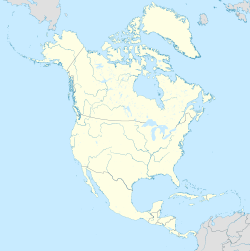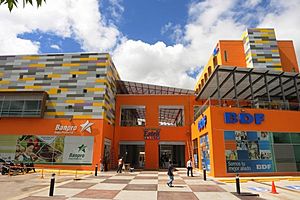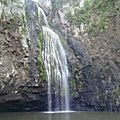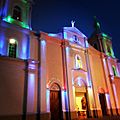Estelí facts for kids
Quick facts for kids
Estelí
Villa de San Antonio de Pavia de Estelí
|
||
|---|---|---|
|
Municipality
|
||
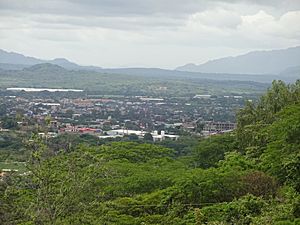
Panoramic view of the City of Estelí
|
||
|
||
| Nickname(s):
" Diamante de la Segovia" ("The Diamond of the Segovia ") name created by Oscar Corea Molina in his radio show "Trampolin 43"
|
||
| Motto(s):
"Estelí, amante del presente, forjador del futuro" ("Estelí, lover of the present, builder of the future")
|
||
| Country | ||
| Department | Estelí Department | |
| Foundation | 1685 | |
| Area | ||
| • Municipality | 796 km2 (307 sq mi) | |
| Elevation | 843.97 m (2,768.93 ft) | |
| Population
(2022 estimate)
|
||
| • Municipality | 131,179 | |
| • Density | 164.80/km2 (426.82/sq mi) | |
| • Urban | 111,244 (8th Nicaragua) | |
| Time zone | UTC-6 | |
| Climate | Aw | |
Estelí (pronounced este-LEE), officially called Villa de San Antonio de Pavia de Estelí, is a city and municipality in the Estelí Department of Nicaragua. It is the 8th largest city in Nicaragua. Most of its people live in the city area, making it a very urban place. Estelí is also a busy business center in the northern part of the country. People often call it "the Diamond of the Segovia." This nickname was created by Oscar Corea Molina on his radio show "Trampolín 43."
The city is located on the Pan-American Highway, about 150 kilometers (93 miles) north of Managua, the capital of Nicaragua. Estelí is a city that is growing quickly. It has a nice climate for most of the year because it is in the northern highlands. The city sits about 844 meters (2,769 feet) above sea level. Around Estelí, you can find mountains covered with pine, oak, and walnut trees. There are also high plateaus, some of which are protected as natural reserves.
Contents
History of Estelí
The first settlement that grew into the city of Estelí was in a place called Villa Vieja. This happened in 1685. A group of Spanish people founded it. They were trying to escape pirate attacks in another area called Nueva Segovia. Later, a new settlement named San Antonio de Pavia was started, and this is where the city of Estelí grew from. Today, you can still find signs of the first church in the Villa Vieja part of the city.
In 1858, Estelí was described as a "little town in a small plain." A river with the same name flowed through it. The area was known for growing a good amount of wheat. By 1920, Estelí had about 8,000 people and was seen as a rich and growing center.
Estelí saw a lot of fighting during the civil war against the Somoza government from 1978 to 1979. The city was heavily damaged during this time. Many buildings were destroyed. After the war, Estelí was rebuilt. Some older buildings still show signs of the fighting, like bullet holes.
Economy and Tourism
The land around Estelí is great for growing tobacco. This tobacco is used to make cigars. After the Cuban Revolution in 1959, many Cuban cigar makers came to Estelí. Because of this, Estelí became one of the most important cities in the world for making cigars. Many of these cigars have won awards.
Estelí also has many language schools where people can learn new languages. There are also many restaurants and hotels. These places serve tourists who visit the natural reserves nearby. Some of the beautiful natural reserves in the area include Miraflor, Tisey-Estanzuela, and Las Brisas-Quiabuc. Other reserves are Tomabú, Tepesomoto, and Moropotente.
Estelí is also known for making it easy to start new businesses and build things. It ranks very high among cities in Latin America for how quickly and easily you can get permits to build or open a business.
City Services and Transport
Estelí has one of the best water supply systems in Nicaragua. Almost everyone in the city has access to clean water. The city also has good systems for getting rid of sewage.
Over the years, at least three airfields were built in Estelí, but none of them are still used today. One early airfield was used in the 1930s for flights carrying passengers. Another airstrip was built to help complete a part of the Pan-American Highway. The third airfield was built in the 1980s but has since become part of the city.
There were plans in the past to connect Estelí to other parts of Nicaragua by railroad. In 1950, there was a proposal for a railway line from Estelí to Matagalpa. This would have connected the city to the Caribbean coast and Managua. In the 1940s, efforts were made to extend Nicaragua's railroad north to Estelí. Some tracks and a bridge were built, but the project was never finished.
Sports in Estelí
Estelí is home to some very successful and popular sports teams.
Football
The city has a famous football (soccer) club called Real Estelí F.C.. Their nickname is "El Tren del Norte," which means "The Train of the North." They play their home games at the Estadio Independencia.
Basketball
Real Estelí Baloncesto is the city's professional basketball team. They play in the Basketball Champions League Americas.
Baseball
Estelí also has a professional baseball team. This makes it one of only three cities in Nicaragua with both a professional football and baseball team. In the 1970s, Estelí had one of the best baseball teams in the country. Famous players like Porfi Altamirano played for them.
Cycling
The city also has a championship-winning professional cycling team called Real Estelí Ciclismo. This team is part of the Cycling Federation of Nicaragua. In 2019, the team won first place in a cycling competition in El Salvador.
Food and Drink
Because Estelí is high up in the mountains, it can get quite cool at night or in the morning, especially in winter. The food in Estelí is hearty, like in other northern mountain regions of Nicaragua. People often eat beef, game meats, veal, rabbit, geese, and sausages. Heavy soups like albóndiga (meatball soup), queso (cheese soup), and res (beef soup) are also popular.
There is a lot of milk and cheese consumed, including smoked or spicy cheeses. Local corn-based dishes are also common. These include delicious montucas, salty-sour repochetas, and semi-sweet güirilas. For breakfast, people often eat chorizo (sausage), refried beans, sour cream, and homemade bread. Black coffee is a favorite drink at any time of day.
Famous People from Estelí
- Pedro X. Molina: A cartoonist who has won awards for his funny drawings.
- Clara Isabel Alegría Vides: A famous Nicaraguan poet, writer, and journalist. She was born in Estelí and is known for her important voice in Central American literature. She won the Neustadt International Prize for Literature in 2006.
- Frank Pineda: A filmmaker from Estelí. He helps make movies as a producer, director of photography, and cameraman. He helped start the Nicaraguan Institute of Cinema.
- Ramón Otoniel Olivas: A Nicaraguan football player and manager for the national team.
Sister Cities
Estelí has "sister city" relationships with several cities around the world. These relationships help promote cultural exchange and friendship.
|
|
In Sheffield, United Kingdom, a part of the walkway along the River Don is named Estelí Parade to honor this connection.
Images for kids
See also
 In Spanish: Estelí para niños
In Spanish: Estelí para niños




